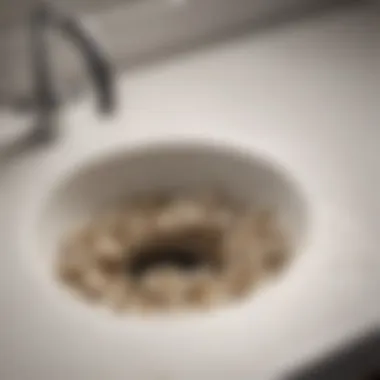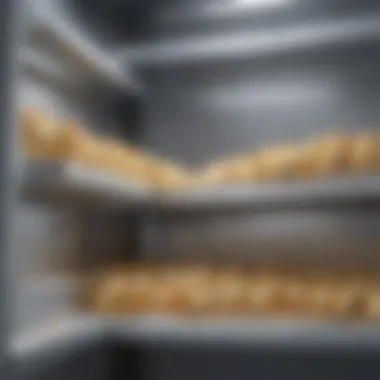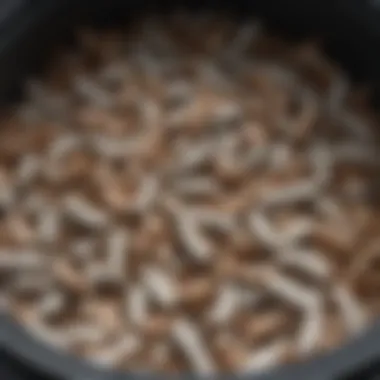Unveiling the Intricacies of White Maggots Infesting Homes


Preventive Pest Control Strategies
Household pest infestations can be a nuisance, but implementing preventive pest control strategies can significantly reduce the likelihood of these unwelcome visitors. One crucial aspect is House Exterior Protection. Sealing cracks around windows, doors, and foundation can thwart potential entry points for pests. Additionally, clearing debris such as leaves and woodpiles can eliminate hiding spots for pests near your home. Furthermore, taking proactive measures like installing door sweeps and repairing screens can prevent pests from sneaking indoors.
When it comes to Yard Maintenance, regular upkeep is key. By maintaining a well-manicured yard, you can deter pests from taking up residence. Trim shrubs and tree branches away from the house, as these can act as bridges for pests to enter. Moreover, removing standing water and clutter from the yard can make it less appealing for pests to congregate.
Indoor Cleanliness is paramount for pest prevention. Employ expert cleaning tips and techniques to keep your home spick and span. Regular vacuuming, sweeping, and decluttering can eliminate food sources and hiding spots for pests. Additionally, sealing food in airtight containers and promptly fixing leaks can significantly reduce the attraction of pests to your home.
A crucial element of pest prevention that is often overlooked is Garbage Disposal. Efficient waste disposal methods, such as using tight-fitting lids on trash cans and disposing of garbage regularly, can help keep pests at bay. Proper garbage disposal not only maintains a clean environment but also deters pests that are drawn to food remnants.
In addition to these strategies, exploring Other Pest Prevention Strategies can further fortify your home against intruders. Consider innovative approaches like using natural repellents, installing ultrasonic pest repellents, or even seeking professional pest control services to create a robust defense against potential infestations.
Introduction
In this comprehensive article aiming to shed light on the issue of white maggots in homes, it is crucial to delve into the intricacies surrounding this troublesome presence. White maggots can be a disturbing sight in any household, prompting concern and a swift call to action. Understanding the root causes, potential risks, and effective eradication methods is essential for maintaining a healthy and hygienic living environment. By exploring the various facets of white maggot infestations, readers can equip themselves with the necessary knowledge to tackle this issue effectively.
Defining White Maggots
Characteristics
White maggots are known for their distinct physical characteristics that set them apart from other pests commonly found in houses. Their small size, white coloration, and worm-like appearance contribute to their identification. These characteristics make them a recognizable nuisance within household settings. Despite their small size, white maggots can quickly multiply if not addressed promptly. Understanding these defining features is crucial in identifying and addressing infestations effectively.
Identification
Identifying white maggots within the house involves carefully inspecting common areas where they are likely to appear. Their presence near organic materials or in damp, dark spaces signals an infestation. By recognizing these specific signs, homeowners can take proactive measures to curb the infestation before it escalates. White maggot identification is key to implementing targeted solutions and preventing their proliferation within the household.
Signs of Infestation
Common Areas
White maggots tend to congregate in areas with organic waste, such as kitchen bins, compost piles, or leaking trash bags. These common areas provide an ample food source for maggots to thrive and multiply. Identifying these hotspots can help pinpoint the source of infestation and guide effective eradication efforts. Ensuring proper waste disposal practices and maintaining cleanliness in these areas is essential to deter maggot activity.
Visual Cues
Visual cues of a white maggot infestation include the presence of small, wriggling maggots in or near organic waste sources. Their movement and clustering behavior indicate an active infestation that requires immediate attention. Recognizing these visual cues enables homeowners to take swift action to address the issue before it spreads to other parts of the house. Visual inspection plays a critical role in monitoring and controlling white maggot infestations.
Importance of Addressing the Issue


Health Risks
The presence of white maggots poses significant health risks to occupants of the house. Maggots can carry diseases and contaminants from decaying organic matter, potentially leading to food contamination and infections if not dealt with promptly. Addressing the health risks associated with white maggots is paramount in safeguarding the well-being of residents and maintaining a sanitary living environment.
Property Damage
In addition to health concerns, white maggots can also cause property damage if left unchecked. They may tunnel into food packages, contaminate surfaces, and compromise the structural integrity of organic materials. Avoiding extensive property damage requires swift intervention to eradicate the infestation and prevent further deterioration. Prioritizing the mitigation of property damage resulting from white maggot infestations is vital for preserving the aesthetics and functionality of the household.
Causes of White Maggots in the House
Understanding the causes of white maggots in the house is foundational in effectively addressing this issue. By diving into the specific elements that lead to maggot infestations, homeowners can better grasp the key factors contributing to this problem. Identifying the sources of these pests allows for targeted solutions, ultimately safeguarding the home environment.
Organic Waste
Food Residues
Discussing food residues sheds light on a significant aspect of the white maggot issue. Food residues act as a primary attractant for maggots, drawing them into homes and creating breeding grounds. The key characteristic of food residues lies in their ability to decompose rapidly, providing an ideal environment for maggot infestations. Despite being a common occurrence in households, improper disposal of food residues can exacerbate maggot problems, making them a crucial consideration for homeowners seeking to combat infestations.
Compost Piles
Exploring compost piles as a contributor to white maggot infestations uncovers a key aspect of organic waste management. Compost piles offer a rich environment for maggots to thrive, as they contain a high concentration of organic matter. While composting is a popular and eco-friendly practice, it can attract maggots if not properly maintained. Understanding the unique features of compost piles, such as their nutrient-rich composition, helps homeowners assess the advantages and disadvantages of incorporating them into their waste management practices.
Moisture and Dampness
Leaky Pipes
Leaky pipes play a significant role in fostering white maggot infestations within homes. The key characteristic of leaky pipes lies in their ability to create damp environments, which are favorable for maggot reproduction. The excess moisture from leaks not only attracts maggots but also contributes to mold growth, posing additional risks to household health. Despite being a common issue, addressing leaky pipes is crucial in mitigating maggot problems and maintaining a dry, pest-free home.
High Humidity
High humidity levels are another factor that can lead to white maggot infestations. The key characteristic of high humidity is its promotion of moisture retention, creating conditions ideal for maggot survival. While humidity regulation is essential for overall comfort, homeowners must be mindful of its impact on pest attraction. Understanding the unique feature of high humidity in relation to maggot infestations helps individuals assess the advantages and disadvantages of humidity control strategies.
Entry Points
Gaps and Cracks
Gaps and cracks in the home serve as primary entry points for white maggots seeking shelter and food sources. The key characteristic of gaps and cracks is their ability to provide easy access for pests, including maggots, into living spaces. Identifying and sealing these entry points is crucial in preventing infestations and maintaining a pest-free environment. While common in older homes, gaps and cracks can pose challenges in pest control, underscoring the importance of proactive maintenance and sealing efforts.


Openings
Openings in doors, windows, and walls represent potential entry points for white maggots to infiltrate homes. The key characteristic of openings is their susceptibility to external interference, allowing pests to enter freely. Homeowners must address these openings promptly to prevent maggot infestations and ensure home security. Understanding the unique features of openings and their role in pest invasion enables individuals to evaluate the advantages and disadvantages of different sealing methods and protective measures.
Preventive Measures
Preventive measures play a crucial role in the overall management of addressing the issue of white maggots in the house. By implementing proactive strategies, homeowners can mitigate the risk of infestations, safeguard their property, and ensure a healthy living environment. In this section, we will delve into the specific elements, benefits, and considerations associated with preventive measures in combating white maggots.
Maintaining Cleanliness
Regular Cleaning
Regular cleaning stands out as a fundamental aspect of preventive measures against white maggot infestations. The meticulous removal of food residues, spills, and organic matter helps eliminate potential breeding grounds for maggots. This routine task not only enhances the aesthetic appeal of the home but also significantly reduces the attractiveness of the environment for pests. Regular cleaning is a popular and beneficial choice highlighted in this article due to its effectiveness in disrupting the lifecycle of maggots and preventing their proliferation. The unique feature of regular cleaning lies in its ability to maintain hygiene standards, contributing to the overall goal of creating an inhospitable environment for pests.
Proper Waste Disposal
Proper waste disposal plays a pivotal role in preventing white maggot infestations by keeping potential food sources out of their reach. By securely sealing and disposing of garbage in a timely manner, homeowners can effectively eliminate the primary attractants for maggots. The key characteristic of proper waste disposal is its ability to minimize odors and reduce the likelihood of pest infestations. This method is a popular choice in this context for its direct impact on preventing maggot populations from thriving. The unique feature of proper waste disposal lies in its dual advantage of cleanliness and pest control, making it an essential component of the preventive measures presented in this article.
Repairing Leaks
Fixing Plumbing Issues
Addressing plumbing problems is essential in preventing excess moisture build-up, which can create an ideal habitat for white maggots to thrive. By promptly fixing leaks and damaged pipes, homeowners can limit the availability of moist environments conducive to maggot infestations. The key characteristic of fixing plumbing issues lies in its direct impact on reducing humidity levels, thereby discouraging pest activity. This method is a beneficial choice for this article given its significant contribution to preventing maggot infestations. The unique feature of fixing plumbing issues is its proactive approach to maintaining a dry and inhospitable setting for pests.
Waterproofing
Waterproofing surfaces such as basements and crawl spaces plays a critical role in preventing moisture intrusion and damp conditions that attract white maggots. By sealing cracks and applying waterproof coatings, homeowners can create a barrier against water ingress and subsequently deter pest infestations. The key characteristic of waterproofing is its ability to enhance structural integrity while simultaneously safeguarding against pest-related damages. This method is a popular choice for this article due to its dual benefits of structural protection and pest prevention. The unique feature of waterproofing lies in its long-term effectiveness in creating a hostile environment for pests, highlighting its relevance in the overall preventive measures discussed.
Sealing Entry Points
Doors and Windows
Securing entry points such as doors and windows is essential in fortifying the home against potential pest invasions, including white maggots. By repairing gaps, installing weather-stripping, and ensuring tight closures, homeowners can restrict the entry of pests into living spaces. The key characteristic of addressing doors and windows lies in its direct impact on preventing pest intrusion and maintaining indoor comfort levels. This method is a beneficial choice for this article as it addresses one of the primary avenues through which maggots can infiltrate the home. The unique feature of sealing doors and windows is its role in enhancing energy efficiency while simultaneously acting as a barrier to unwanted pests.
Foundation Cracks
Repairing foundation cracks is crucial in preventing pest access to the interior of the house, as these openings can serve as entry points for white maggots. By sealing cracks with appropriate materials and undertaking necessary repairs, homeowners can effectively block off potential pathways for pest infiltration. The key characteristic of addressing foundation cracks lies in its ability to reinforce the structural integrity of the home and prevent pest-related damages. This method is a popular choice for this article due to its direct correlation with reducing the risk of maggot infestations. The unique feature of repairing foundation cracks is its long-term impact on pest exclusion, emphasizing its importance in the comprehensive preventive measures outlined.


Treatment Options
Understanding the importance of treatment options is pivotal in mitigating the issue of white maggots infesting your home. Treatment options offer a sustainable approach to eradicating these pests and preventing future infestations. By exploring different treatment methods, homeowners can make informed decisions to effectively address the problem at hand.
Natural Remedies
Vinegar Solution
Delving into natural remedies, the vinegar solution stands out as a potent weapon against white maggots. Its acidic nature acts as a powerful deterrent, effectively eliminating maggots without posing any harm to the environment or residents. The vinegar solution's key characteristic lies in its versatility, as it can be easily concocted at home using common household ingredients. This eco-friendly option not only rids your house of maggots but also serves as a cost-effective solution in comparison to commercial pesticides. Despite its effectiveness, the vinegar solution may have a strong odor, which could be considered a minor disadvantage. However, its benefits far outweigh this slight drawback in combating white maggots.
Boric Acid
When considering natural remedies, boric acid emerges as a reliable ally in the battle against white maggots. Known for its insecticidal properties, boric acid effectively targets and eliminates maggots while remaining safe for use indoors. The key characteristic of boric acid lies in its long-lasting residual effect, continuing to combat pests even after application. This popular choice in pest control for white maggots offers a comprehensive solution without harsh chemicals detrimental to the household. While boric acid is effective, it should be used cautiously as it can be toxic if ingested in large quantities. However, its advantages in controlling white maggots make it a favorable option for homeowners seeking sustainable and potent remedies.
Professional Pest Control
Extermination Services
Exploring professional pest control options, extermination services come to the forefront as a reliable and efficient way to tackle white maggots infestations. Extermination services offer a comprehensive approach, identifying the source of the infestation and implementing targeted solutions to eradicate maggots effectively. The key characteristic of extermination services lies in the expertise and specialized techniques employed by professionals, ensuring thorough pest removal and prevention. Opting for extermination services is a popular choice among homeowners facing persistent pest issues, providing peace of mind and long-term solutions. While effective, the main disadvantage of extermination services could be the cost involved, but the benefits of a maggot-free home outweigh this aspect.
Consultation
In the realm of professional pest control, consultation services play a crucial role in addressing white maggot infestations. Consultation services offer homeowners expert advice on identifying, treating, and preventing maggots in the house. The key characteristic of consultation lies in the personalized approach, tailoring solutions to cater to specific infestation challenges. Choosing consultation services proves advantageous as it empowers homeowners with knowledge and strategies to combat white maggots effectively on their own. However, a potential disadvantage could be the need for multiple consultations depending on the extent of the infestation. Despite this, the insightful guidance and tailored solutions provided make consultation services a valuable asset in the fight against white maggots.
Conclusion
Summary
Key Takeaways
The Key Takeaways section distills the essential points and recommendations offered in this article. It emphasizes the importance of maintaining cleanliness, repairing leaks, and sealing entry points as primary preventive measures against white maggot infestations. The key characteristic of Key Takeaways lies in its pragmatic nature, providing actionable steps that readers can implement to safeguard their homes. One unique feature of Key Takeaways is its emphasis on the immediate implementation of preventive measures to avert potential infestations, making it a valuable and proactive choice for readers concerned about this issue.
Final Thoughts
Final Thoughts encapsulate the overarching sentiment to underscore the long-term implications of neglecting the issue of white maggots in the house. It serves as a reminder of the continuous effort required to uphold a pest-free environment. The key characteristic of Final Thoughts is its emphasis on sustainable practices and continuous vigilance in monitoring for any signs of infestation. Through Final Thoughts, readers are encouraged to adopt a proactive stance towards pest control and commit to ongoing prevention efforts, ensuring a safe and healthy living environment free from white maggot infestations.
Future Prevention
Sustainable Practices
Sustainable Practices represent a crucial aspect of long-term prevention strategies against white maggot infestations. By incorporating sustainable practices such as proper waste management, environmentally friendly pest control methods, and eco-conscious habits, homeowners can mitigate the risk of infestations while minimizing impact on the ecosystem. The key characteristic of Sustainable Practices lies in its harmonious approach towards pest management and environmental stewardship, making it a popular and responsible choice for maintaining a healthy home environment.
Continuous Monitoring
Continuous Monitoring is the cornerstone of effective pest control and prevention. By establishing a regular monitoring routine, homeowners can promptly detect any signs of white maggot activity and take immediate action to address the issue. The key characteristic of Continuous Monitoring is its proactive nature, enabling early intervention and eradication of infestations before they escalate. By integrating continuous monitoring practices into their household routines, individuals can stay ahead of potential infestations and uphold a pest-free living space effectively.



